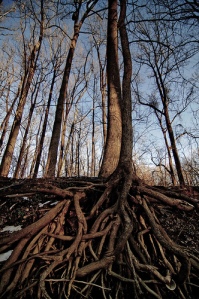Unlike trees, we can move. We also have the capacity to communicate across the whole earth through the internet and global communication. Especially these days with instant communication, it can be easy to forget that there is a part of us which also needs roots and stability. Like trees, we need not just our branches reaching heavenwards (our brains and the internet), but also roots burrowing downward. http://www.wakingtimes.com/2012/05/02/how-trees-communicate-video/ We need to connect with the earth, with our feet, with our physical body and to the people and places in front of us.
photo by Anna Levinza, Rock Creek Park
Indeed we talk about “mother earth” and our first experience of the earth is our time in our mother’s womb when we actually did burrow down into the lining of the womb, forming “roots” as our placenta developed its blood vessels and attached to the womb. Touch is our first sense to develop at around 8 weeks, indicating its importance as our most fundamental sense. Sight is our last sense to develop and indeed does not fully mature till many months after we are born.
One of the main ways in which we grow and develop in the womb is by physically moving: movement helps form connections in our brains and support its development. This applies not only in the womb, but important connections are also made during birth and the first year of our life. Throughout life, we continue to need movement to support not only our physical but emotional body and brain.
When people spend too much time in front of computer screens and mobile phones, they are stimulating their brain in a different way, which is also important. However the brain can become over -stimulated in such a way that they can become disconnected from their body and the earth. We see this all the time with people sometimes spending more time looking at their iphones than being present with the people they are with. In extreme cases, this virtual world can become more real than physical reality and may lead to feelings of alientation from others or even develop into mental illness. .
In our cultural excitement about always expanding and finding new places, we can easily forget how important the slow and simple things of life are in supporting us to be present in our bodies and where we are physically. The slow movement http://en.wikipedia.org/wiki/Slow_Movement has sprung from this idea. It is not a call to go backwards but a reminder to slow down our pace of living. The slow food movment http://en.wikipedia.org/wiki/Slow_Food reminds us to enjoy local produce and know where it has come from and share the process of cooking with friends and family. The slow travel movement is about taking time to travel through a place and understand its people rather than simply visiting its landmarks.
The setting down of roots takes time and is built up by sharing food and physically being connected with people and place. Simply living in the same space over a number of years, witnessing the changing of the seasons and within the community over year to year supports this process. It is easy to under-estimate this sense of connection with place: especially those places where our family is from. Again it is a very recent phenomenon that families move around so much and so most of us have much less a sense of rooting than our ancestors. However, despite this most of us have some sense of the place and the roots that our ancestors put down there over many years.
Migration can, as we know, engender feelings of displacement, especially when it happens without free choice, such as the Irish and Jewish migrations. When families and cultures are displaced abruptly feelings of disconnection and rootlessness can occur. People literally feel cut off from a part of themselves. I notice this especially when I work with women during pregnancy: they often want to feel close to their mother, even if for years they have lived in another country.
Some of you might point to the long history we have of nomadic cultures. However, we have to remember that in the past these cultures were walking cultures. People moved but they had a strong sense of connection with the land they were travelling through. Our movements are now faster paced, especially as air travel can mean that we are not very connected with where we are. Once again we can understand why the slow movement has arisen.
Given the changes and the speed of modern life, it is important to remember that we still need roots. We need to be able to more consciously make connections with the places we inhabit, because we spend less time being rooted than our ancestors did. I am not suggesting that we can’t enjoy movement and the possibilities that modern life has opened up to us: but we must remember to balance this faster pace, this expansive nature of life, with times of slowness, taking time and feeling rooted. We can’t just expand up into our branches. Without roots, we would be adrift. Like trees, let us remember the importance of being settled, rooted, grounded, and value slowness as well as speed.



